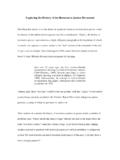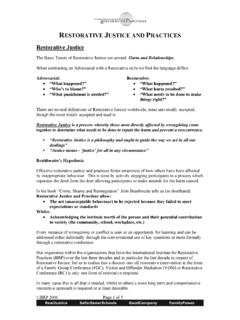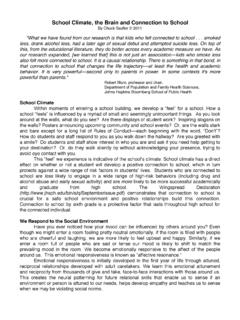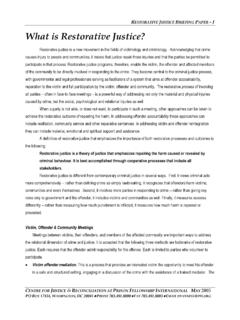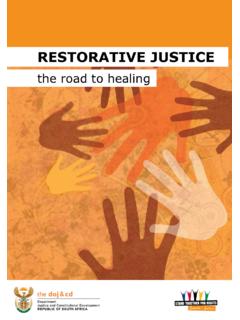Transcription of Building a Restorative Practice Curriculum in …
1 Building a Restorative Practice Curriculum in Middle and High Schools in the !Why do we need to have a Restorative Practice Curriculum ? ! Gaining funding for the delivery of a Restorative Practice program is sometimes dependent upon producing a Curriculum to show a funder exactly what we will be doing in schools.! This presentation is another effort at producing a Curriculum for middle and high schools based upon the following resources:" Restorative practices Development Team. (2003). Restorative practices for Schools. School of Education. The University of Waikato, Hamilton New Zealand." Winslade, J., & Monk, G. (2008). Practicing Narrative Mediation. Loosening the Grip of Conflict.
2 San Francisco, Jossey-Bass." Claassen, R., & Claassen, R. ( 2008). Discipline that Restores: Book Study Guide. Center for Peace Making & Conflict Studies. Fresno." Claassen, R., & Claassen, R. ( 2008). Discipline that Restores. Strategies to Create Respect, Cooperation, And Responsibility in the Classroom. South Carolina: BookSurge Publishing" Hendry, R. (2009). Building and Restoring Respectful Relationships in Schools. A Guide to Restorative Practice . London: Routledge." Hopkins, B. (2004). Just Schools. A Whole School Approach to Restorative Justice. London: Jessica Kingsley Publishers" Costello, B., Wachtel, J., & Wachtel, T. (2010). Restorative Circles in Schools. Building Community and Enhancing Learning.
3 Bethlehem, PA: International Institute for Restorative practices ." Costello, B., Wachtel, J., & Wachtel, T. (2009). The Restorative practices Handbook. Bethlehem, PA: International Institute for Restorative practices ." A stated underlying philosophy Assumptions Goals Objectives Strategies Instructional materials Time frame Accountability What is a Curriculum exactly?! Restorative Practice Philosophy! Restorative Practice is guided by an ethic of care and justice. Restorative Practice is an approach to build community, promote a culture of care, foster a sense of belonging, and invite responsibility and provide accountability, reparation, reconciliation and reintegration where harm has occurred.
4 Other Philosophical Issues! A central premise of Restorative Practice is that people are happier, more cooperative, productive, more likely to make positive changes in their behavior and improve academic learning when those in positions of authority do things with them, rather than to them or for them (IIRP). A punitive and authoritarian stance or a permissive and paternalistic stance is not as effective as a Restorative and participatory one. Restorative Practice builds social capital and achieves social discipline through participatory learning and decision-making (IIRP). Restorative Practice seeks to transform the relational culture of schools, by engaging the school community in group decision-making, cooperative learning, community involvement, and by paying attention to the stories of resilience in the face of challenges.
5 Academic success is dependent upon fostering the social and emotional wellbeing of the school community and when this wellbeing is threatened, efforts must be made to address these threats and restore the relational climate and make things right again. Restorative Practice Assumptions! Based upon mutual respect and appreciation" Belief in people s ability to resolve their own problems" Acceptance of diversity" An inclusive approach to problem solving so that feelings, needs and views of everyone in the community are taken into account " There is a congruence of beliefs and actions - walking the talk"Goals of Restorative Practice in the Schools! The goals are to:" Make the schools and the community safer.
6 " Raise morale and build connection, promote respect among the school community and foster a sense of belonging for students and staff in the school." Raise attendance, reduce behavioral referrals, and dramatically diminish suspensions and expulsions." Eliminate bullying and all kinds of violence in the school." Reduce staff turnover and burnout." Raise academic performance." Restorative Practice " Curriculum Domains"Family-Group "Conferences"Victim-Offender "Conferences!Adult Mediation"The Challenge"8 hour workshop!Whole Community & Whole School Engagement"Establishing a Restorative Relational Foundation and Developing a Clear Vision"Whole School Development of Relationship Management Policy Social Discipline Window" 8 hour workshop !
7 Conflict Resolution" School-wide Peer Mediator Mentor Teams"Buddying/Mentoring"Preferred Identity Development & Resiliency Discovery "Bully Proof Program"Teen Dating Violence"Having Difficult Conversations"Problem-Solving Circles! Restorative Debriefing after Critical "Incidents"Narrative Mediation "Workshops for: Active Non-Judgmental Listening, Understanding Anger"Cultural Responsiveness, Emotional literacy and Intelligence, Empathy & Rapport"Challenging Oppression & Prejudice, Social Awareness and "Social-Emotional Skill, Tomkin s Shame and Pride"Being a Listening School "Community- Building Circles for Staff, Students, School Council !8 hour workshop"Achieving !Systemic and !
8 Social Policy Change!as a Restorative !School and Community!Implementing School-wide Programs !addressing the !Social-emotional Climate! Restorative !Interviewing!Responding circles! Restorative Conferences!Formal Conferencing!Capacity- Building for ! Restorative Development!Affective statements, Affective Questions!Impromptu Conferences & Circles!Adaption of Lesley Oliver s !Model on a Relational !Foundation of School Culture, !November 2006! Restorative Practice Curriculum Domain Objectives! Achieving Systemic and Social Policy Change as a Restorative School and Community " Capacity- Building for Restorative Development" Implementing School-wide Programs" RestorativeInterviewing" Restorative Conferences"Introducing Restorative Practice to the School and the Community!
9 Goals: Achieving Systemic and Social Policy Change as a Restorative School and Community - To create an environment where the school values of belongingness, connectedness and a respectful code of conduct are shared among all members of the community. Objectives: Participants after completing the training will: Acquire approaches to discipline that restores the strained relationships rather than restoring a punitive authority. Be exposed to school strategies that concentrate on appreciation, alternative possibilities, and hope that can replace judgment, deficit and failure. Strive to shows excellence in demonstrating respect and honoring the dignity of the person.
10 Celebrates diversity of the school members and apply strategies where every voice is heard in the school rather than just the loudest or the weightest. Appreciate the importance of showing hospitality to parents, families and visitors to the school. Strategies: Use Belinda Hopkin s (2004) Strategies for culture change in the school. The school community have ideas about what they need from one another to get their needs met. Exercise: 1. What do you need from others to work at your best. Make a list. 2. Then select the 3 most important things I need without which I could not function effectively. Use color dots to show choices. 3. Use the circle for disclosing needs: I don t feel respected I do feel respected This sharing provides information about practical measures that can be taken to identify values creates a template for a set of guidelines for behavior and provides a basis for rule making.
